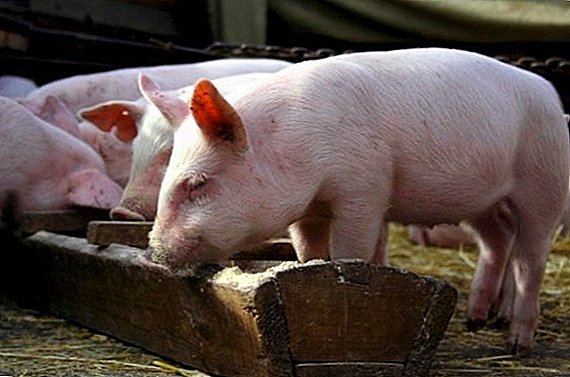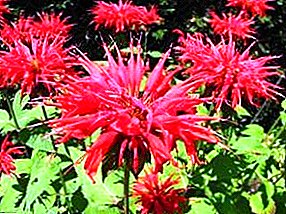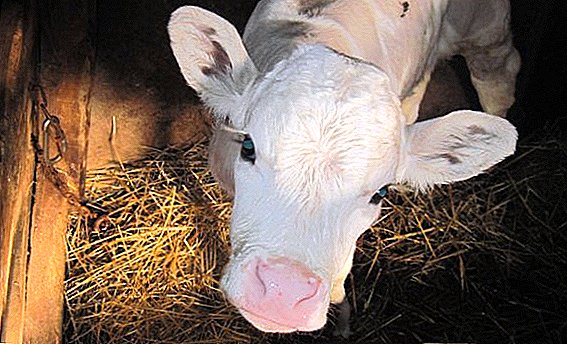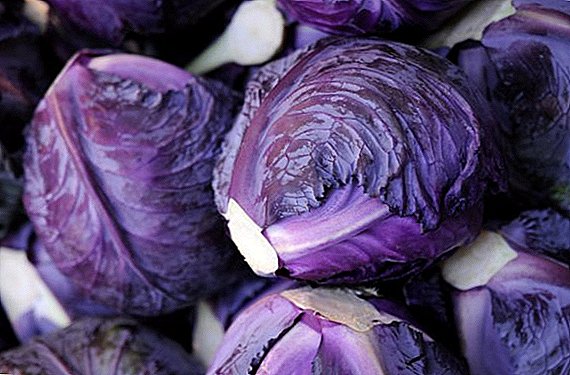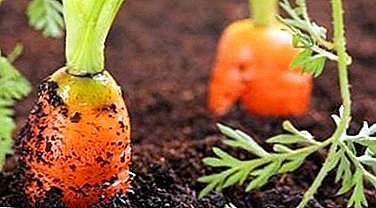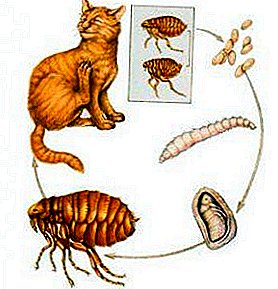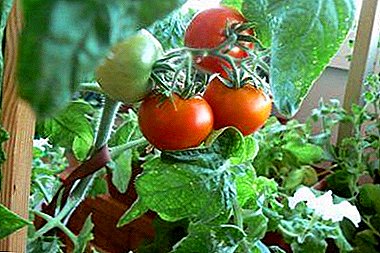 "Megaton F1" - a popular variety of cabbage, known for its high yield. In order to gather a rich harvest, it is necessary to choose the right place for planting, to ensure adequate watering and care. In this article we describe all the nuances of growing "Megaton" from sowing to harvest.
"Megaton F1" - a popular variety of cabbage, known for its high yield. In order to gather a rich harvest, it is necessary to choose the right place for planting, to ensure adequate watering and care. In this article we describe all the nuances of growing "Megaton" from sowing to harvest.
Features cabbage hybrid
Variety cabbage "Megaton F1" refers to a number of Dutch varieties. Heads of cabbage have large sheets of rounded shape, covered with a waxy coating. The edge of the sheet is wavy. Heads tight, rounded, slightly flattened. The weight of a mature head of cabbage is 5-6 kg. Some cabbage heads may weigh more than 10 kg. Main cabbage characteristic varieties "Megaton" is yield.  With proper watering and care, it is possible to collect up to 960 kg from 1 hectare. The average yield is higher than that of other varieties, by 20-30%. Ripening occurs at 136-168 days after germination.
With proper watering and care, it is possible to collect up to 960 kg from 1 hectare. The average yield is higher than that of other varieties, by 20-30%. Ripening occurs at 136-168 days after germination.
Did you know? "Megaton" contains 43 mg of vitamin C per 100 g. In cabbage it is present in its pure form and in a stable form (ascorbigen).
Advantages and disadvantages
Cabbage "Megaton F1" has many advantages, including:
- resistance to frost;
- high yield;
- immunity to fungal diseases, which include gray mold, fusarium wilt, keel;
- good taste;
- small stalk;
- transportation does not affect the presentation;
- head does not crack when the weather changes.
- short duration of storage (ripe cabbage stored from 1 to 4 months);
- leaves a little tough at first after harvest;
- lower sugar content than other varieties;
- when salted the color of the leaves becomes darker.
Sowing seeds in open ground (seedless)
An important advantage of cabbage varieties "Megaton F1" is the possibility of sowing on open ground without pre-growing seedlings. Shoots appear 3-10 days after sowing.
Check out also the agrotechnics of growing other types of cabbage: red cabbage, broccoli, savoy, kohlrabi, Brussels, Beijing, cauliflower, Chinese pak choi, kale.
Terms for sowing
The best time to plant is first decade of may. The optimum temperature for seed germination is + 12-19 ° C. The shoots may die in case of small frosts, while large heads of cabins tolerate low temperatures down to -8 ° C.  Consider the features of your climate zone. If in the beginning of May frosts are possible, then transfer the sowing to the end of the month - heading out will have time to grow until mid-October. Also "Megaton" can be sown in March for seedlings, followed by planting in early June.
Consider the features of your climate zone. If in the beginning of May frosts are possible, then transfer the sowing to the end of the month - heading out will have time to grow until mid-October. Also "Megaton" can be sown in March for seedlings, followed by planting in early June.
Location selection
For good growth varieties of cabbage "Megaton" is more suitable sunny open place. There are too many shade areas under fruit trees. Also, do not fit the area under the north side of the house or shed. If after the emergence of seedlings established hot sunny weather, in the first days it is recommended to create a shade so that young plants do not get stung.  Are not suitable for growing "Megaton" plots, which last year grew turnips, radishes or cabbage. Preferred precursors are potatoes, carrots and tomatoes.
Are not suitable for growing "Megaton" plots, which last year grew turnips, radishes or cabbage. Preferred precursors are potatoes, carrots and tomatoes.
Site preparation
Loamy soil is best for growing this variety of cabbage. The site intended for sowing "Megaton", in the autumn, clean off the remnants of plants. When digging, add a mixture of humus and manure (10 square meters of mixture per 1 square meter of soil). If there is a soil with high acidity on your site, pour lime or ash during digging, this will reduce the risk of developing fungal diseases. 
Seed preparation
To speed up germination seeds need to be prepared. In a small amount of water, the seeds are heated to 50 ° C. After cooling, the water is drained, and the seeds are immersed in a solution of "Zircon" (or other fungicidal agent). Dry the treated seeds. Now they are ready for sowing directly in open ground.
Important! If you purchased seeds previously treated with a fungicide, then preparation is not required - you can sow immediately.
Sowing seeds: the pattern and depth
The planting pattern, like other varieties, is in rows. Do not forget that the cabbages of this type of cabbage are large, so the distance between the rows should be at least 40 cm. Try not to sow thickly. The variety "Megaton" is characterized by a large number of shoots (germinates up to 80-100% of what was sown). Seeds are sown to a depth of 1-3 cm. 
Competent care - the key to a good harvest
You will get a good harvest of cabbage, if you provide optimal conditions: water well, loosen the soil, regularly weed the beds. Pay attention to the presence of pests. In addition to fungal diseases, plants can be harmed by the bear and insects.
Watering, weeding and loosening
Before the emergence of the seedlings is necessary wet with a sprayer. Spray watering can lead to seed washout. Thinning begins when the first three leaves appear on the seedlings. Repeated thinning is carried out when there are six leaves on the plants. Megaton loves space. Make sure the plants do not grow too thick.  Watering cabbage sprouts is necessary every 2-3 days. For every square meter of soil, pour 7-10 liters of water. When the head starts to pour, reduce watering, and 2-3 weeks before harvesting completely stop watering. This prevents cracking of the head.
Watering cabbage sprouts is necessary every 2-3 days. For every square meter of soil, pour 7-10 liters of water. When the head starts to pour, reduce watering, and 2-3 weeks before harvesting completely stop watering. This prevents cracking of the head.
Hilling bushes
Hilling done for the prevention of diseases of the legs and rotting of large fruits, which bend down to the ground. It is also necessary for the formation of the root system in young plants. Spud shoots after the second thinning, it contributes to the formation of a thick root. Re-hilling do in 1.5 months during the formation of the head. Using sap, pull off the top layer of soil within a radius of 20-25 cm to the root of the plant.
Important! Hilling spend in dry weather a few days after watering. Wet soil can cause rotting feet.
Top dressing
The first dressing produce after the second thinning. To do this, use nitrogen fertilizers. After 2-3 weeks for a good formation of the root system, saltpeter and potassium salts are added (5 g per 1 sq. M).  Nitrogenous fertilizers are applied again during the formation of the head. To enrich the soil with nitrogen in addition to the drug (at the rate of 30 g per 10 l of water), it is possible to use chicken infusion or cow manure. The following feeding is done in 2-3 weeks. In a 10-liter bucket with water intended for irrigation, dissolve 20 g of saltpeter and 30 g of superphosphate. Stir the fertilizer well and water the plants evenly.
Nitrogenous fertilizers are applied again during the formation of the head. To enrich the soil with nitrogen in addition to the drug (at the rate of 30 g per 10 l of water), it is possible to use chicken infusion or cow manure. The following feeding is done in 2-3 weeks. In a 10-liter bucket with water intended for irrigation, dissolve 20 g of saltpeter and 30 g of superphosphate. Stir the fertilizer well and water the plants evenly.
After fertilizer application, it is necessary to weed and loosen the soil.
Important! With an insufficient nitrogen content in the soil, the head is growing slowly, and the leaves have a yellowish tint.
Harvesting and storage of the crop
Harvest time depends on climatic conditions. Maturation usually occurs in late September or October. Cut cabbages in dry weather, after stopping watering. Pay attention that there are no signs of rot on the stalk.
Store Megaton in a dry basement or in a well-ventilated cellar. The optimal storage temperature is from 0 to +4 ° С. Cabbage is placed on the shelves stalk up. So heads can be stored for 1-4 months. You can extend the shelf life if you hang the cabbage by the root on a rope or wire.  A good way to protect the crop from rot is to wrap the cabbages with cling film. For long-term storage, "Megaton" is pickled or salted.
A good way to protect the crop from rot is to wrap the cabbages with cling film. For long-term storage, "Megaton" is pickled or salted.
Did you know? In the state of West Virginia (USA), there is a law prohibiting boiling cabbage, because the characteristic obsessive smell arising from this process can cause inconvenience to neighbors.
Observing our recommendations for the care of cabbage variety "Megaton F1", you will get a bountiful harvest and you will be able to appreciate the advantages of a hybrid Dutch variety. High yield and excellent taste of "Megaton" make it one of the most popular varieties for cultivation in our region.


